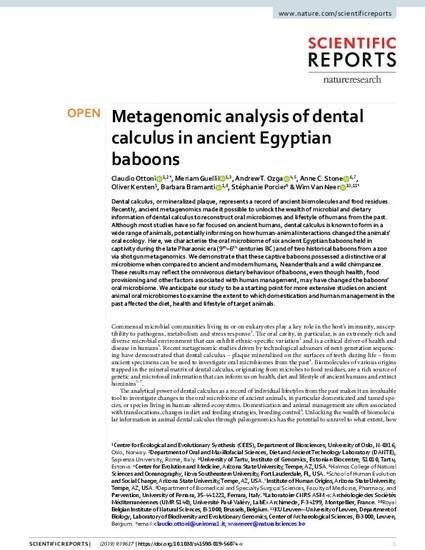
- Biology and
- Life Sciences
Dental calculus, or mineralized plaque, represents a record of ancient biomolecules and food residues. Recently, ancient metagenomics made it possible to unlock the wealth of microbial and dietary information of dental calculus to reconstruct oral microbiomes and lifestyle of humans from the past. Although most studies have so far focused on ancient humans, dental calculus is known to form in a wide range of animals, potentially informing on how human-animal interactions changed the animals’ oral ecology. Here, we characterise the oral microbiome of six ancient Egyptian baboons held in captivity during the late Pharaonic era (9th–6th centuries BC) and of two historical baboons from a zoo via shotgun metagenomics. We demonstrate that these captive baboons possessed a distinctive oral microbiome when compared to ancient and modern humans, Neanderthals and a wild chimpanzee. These results may reflect the omnivorous dietary behaviour of baboons, even though health, food provisioning and other factors associated with human management, may have changed the baboons’ oral microbiome. We anticipate our study to be a starting point for more extensive studies on ancient animal oral microbiomes to examine the extent to which domestication and human management in the past affected the diet, health and lifestyle of target animals.
Available at: http://works.bepress.com/andrew-ozga/38/

©The Author(s) 2019.
This article is licensed under a Creative Commons Attribution 4.0 International License, which permits use, sharing, adaptation, distribution and reproduction in any medium or format, as long as you give appropriate credit to the original author(s) and the source, provide a link to the Creative Commons license, and indicate if changes were made. The images or other third party material in this article are included in the article’s Creative Commons license, unless indicated otherwise in a credit line to the material. If material is not included in the article’s Creative Commons license and your intended use is not permitted by statutory regulation or exceeds the permitted use, you will need to obtain permission directly from the copyright holder. To view a copy of this license, visit http://creativecommons.org/licenses/by/4.0/.